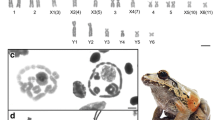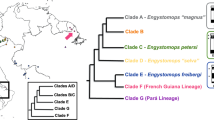Abstract
The chromosomes of the Chilean frogEupsophus insularis are described for the first time. This species has a chromosome number of 2n=30, and based on the karyotype it is concluded thatE. insularis is closely related toE. migueli. E. insularis has an XX/XY system of sex determination, and pericentromeric constitutive heterochromatin is present in all chromosomes except in the Y chromosome. It is postulated that the Y chromosome is derived from a small ancestral metacentric chromosome that lost its heterochromatic segment.
Similar content being viewed by others
References
Bogart JP (1970) Systematic problems in the amphibian family Leptodactylidae (Anura) as indicated by karyotypic analysis.Cytogenetics 9: 369–383.
Formas JR (1980) The chromosome ofEupsophus calcaratus and the karyological evolution of the genusEupsophus (Anura: Leptodactylidae).Experientia 36: 1163–1164.
Formas JR (1991) The karyotypes of the Chilean frogsEupsophus emiliopugini andE. vertebralis (Amphibia: Anura: Leptodactylidae).Proc Biol Soc Wash 104: 7–11.
Iturra P, Veloso A (1989) Further evidence for early sex chromosome differentiation of Anuran species.Genetica 78: 25–31.
Jones KW, Singh L (1981) Conserved repeated DNA sequences in vertebrates sex chromosomes.Hum Genet 58: 46–53.
Jones KW (1984) The evolution of sex chromosomes and their consequences for the evolutionary process. In: Bennett MD, Gropp A, Wolf U, eds.Chromosomes Today. London: Allen & Unwin, pp. 241–255.
Levan A, Fredga K, Sandberg A (1964) Nomenclature for centromeric position on chromosome.Hereditas 52: 201–220.
Nishioka M, Miura M, Saitoh K (1993) Sex chromosome ofRana rugosa with special reference to local differences in sex-determining mechanism.Sci Rep Lab Amphib Biol Hiroshima Univ 12: 55–81.
Nishioka M, Hanada H, Miura M, Ryuzaki M (1994) Four kinds of sex chromosomes inRana rugosa.Sci Rep Lab Amphib Biol Hiroshima Univ 13: 1–34.
Reig O (1972)Macrogenioglottus and the South American bufonoid toads. In: Blair FW ed.Evolution of the Genus Bufo. Austin and London: Univ of Texas Press, pp. 14–36.
Rufas JS, Iturra P, De Souza W, Sponda P (1982) Simple silver staining procedures for the location of nucleolus and nucleolar organizer under light and electron microscopy.Arch Biol 93: 267–274.
Schempp W, Schmid M (1978) Chromosome banding in Amphibia. VI. BrdU-replication patterns in Anura and demonstration of XX/XY sex chromosome inRana esculenta.Chromosoma 83: 697–710.
Schmid M (1980) Chromosome banding in Amphibia. V. Highly differenciated ZZ/ZW sex chromosomes and exceptional genome size inPyxicephalus adspersus (Anura:Ranidae).Chromosoma 80: 69–96.
Schmid M (1983) Evolution of sex chromosomes and heterogametic systems in Amphibia.Differentiation 23 (suppl.): S13-S22.
Schmid M, Haaf T, Geile T, Sims S (1983) Chromosome banding in Amphibia. VIII. An unusual XY/XX-sex chromosome system inGastrotheca riobambae (Anura:Hylidae).Chromosoma 88: 69–82.
Schmid M, Steinlein C, Feichtinger W, de Almeida CG, Duellman DE (1988) Chromosome banding in Amphibia. XIII. Sex chromosome, heterochromatin and meiosis in marsupial frogs.Chromosoma 97: 33–42.
Schmid M, Steinlein C, Friedl R et al. (1990) Chromosome banding in Amphibia. XV. Two types of Y chromosomes and heterochromatin hypervariability inGastrotheca pseustes (Anura: Hylidae).Chromosoma 99: 413–423.
Schmid M, Steinlein C, Feichtinger W (1992) Chromosome banding in Amphibia. XVII. First demonstration of multiple sex chromosome in amphibians:Eleutherodactylus maussi (Anura: Leptodactylidae).Chromosoma 101: 284–292.
Schmid M, Ohta S, Steinlein C, Guttenbach M (1993) Chromosome banding in Amphibia. XIX. Primitive ZW/ZZ sex chromosomes inBuergeria buergeri (Anura: Rhacophoridae).Chromosoma 62: 238–246.
Sumner AT (1972) A simple technique for demonstrating centromeric heterochromatin.Exp Cell Res 75: 304–306.
Author information
Authors and Affiliations
Additional information
accepted for publication by M. Schmid
Rights and permissions
About this article
Cite this article
Cuevas, C.C., Formas, J.R. Heteromorphic sex chromosomes inEupsophus insularis (Amphibia: Anura: Leptodactylidae). Chromosome Res 4, 467–470 (1996). https://doi.org/10.1007/BF02265054
Received:
Accepted:
Issue Date:
DOI: https://doi.org/10.1007/BF02265054




